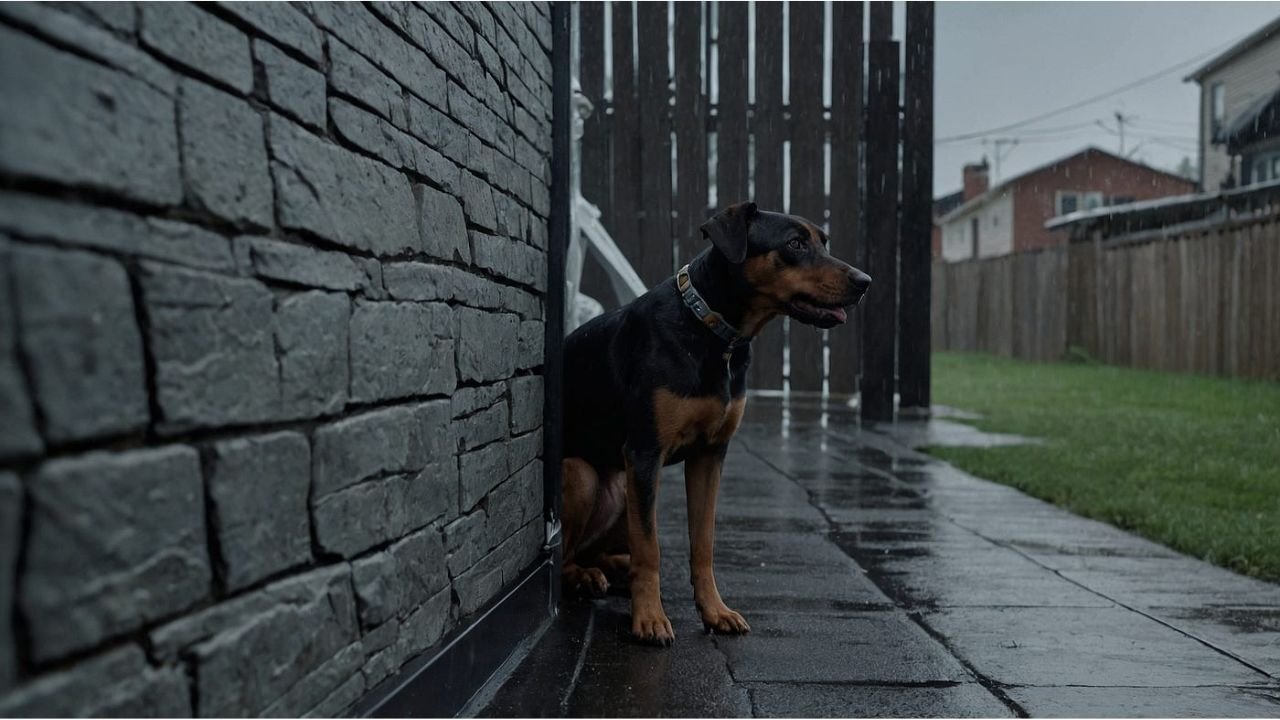When the skies darken, and the rumble of thunder begins, it’s not uncommon for pet owners to notice their dogs becoming anxious. This anxiety can sometimes lead to destructive behaviors, leaving your home’s walls and furniture at risk. Understanding how to protect walls from dog-induced chaos during a storm is crucial for both the safety of your home and the comfort of your pet. This blog will guide you through practical strategies and real-life stories to help you weather the storm—literally and figuratively—with your furry friend.
Understanding Dog Anxiety During Storms
Why Storms Scare Dogs
Many dogs become frightened during storms due to the loud noises, flashes of lightning, and changes in barometric pressure. Their acute senses pick up on these changes, triggering a flight-or-fight response. It’s not just the noise that bothers them; dogs can sense the static electricity in the air, which adds to their distress.
The Consequences of Storm-Induced Anxiety
A dog’s natural reaction to fear might involve seeking a place to hide or finding ways to release pent-up energy. This can manifest in behaviors like scratching at doors, chewing on furniture, or even trying to burrow into walls. These behaviors, while a natural response to fear, can cause significant damage to your home.
Recognizing Signs Before the Storm Hits
Pay attention to your dog’s body language when a storm is approaching. Common signs include trembling, excessive drooling, whining, and pacing. Recognizing these signs early can allow you to implement calming strategies before your dog becomes too distressed.
Tips on Preparing Your Home
Creating a Safe Space for Your Dog
Designate an area in your home where your dog can feel safe during a storm. This space should be away from windows and doors to minimize exposure to the sights and sounds of the storm. Add comfortable bedding and favorite toys to create a cozy environment.
Home Modifications to Prevent Damage
Consider installing protective barriers around areas of your home that are frequently targeted by your dog during storms. Use furniture protectors and wall guards to prevent scratching and chewing. You might also use pet gates to restrict access to certain areas.
Using Calming Colors and Scents
Enhancing your dog’s safe space with calming colors and scents can help soothe their nerves. Lavender and chamomile are known for their calming properties and can be used via diffusers or pet-safe sprays.
Behavioral Strategies for Calming Your Dog During Storms
Training Techniques
Training your dog to associate storms with positive experiences can help reduce anxiety. Use treats and praise to reinforce calm behavior during storms. Begin desensitization training by playing recordings of storm noises at a low volume, gradually increasing it as your dog becomes accustomed to the sound.
Calming Products
There are various products available designed to calm anxious dogs. ThunderShirts, for example, apply gentle pressure to your dog’s torso, providing a soothing effect. Additionally, consider using pheromone diffusers that mimic the calming scent of a mother dog.
The Role of Music and White Noise
Playing calming music or white noise can help drown out the sound of a storm. Music with a slow tempo and low volume is often effective at reducing stress levels in dogs. There are even playlists specifically curated for calming pets during stressful events.
Real-Life Stories and Examples
Success Story 1: Reducing Anxiety with a Cozy Den
Sarah, a long-time dog owner, discovered her golden retriever, Max, responded well when she created a storm “den” in the laundry room. By adding blankets, pillows, and a few of Max’s favorite toys, Sarah found that Max felt more secure and was less likely to dig or chew during storms.
Success Story 2: Training Transforms Behavior
Mark’s Labrador, Daisy, had a history of frantic pacing and barking during storms. After consulting a professional trainer, Mark began using desensitization techniques and positive reinforcement. Over time, Daisy started to remain calm during storms, even seeking out Mark for comfort rather than reacting destructively.
Success Story 3: Finding Calm in Music
Lisa invested in a pet-specific music playlist, which she plays whenever a storm is forecast. Her dog, Bella, now associates the music with relaxation, staying calm and happy even when the thunder rumbles outside.
You May Also Like: What the Heckin Dog: Meme Magic Explored!
Conclusion
By understanding your dog’s anxiety and implementing the above strategies, you can protect your home and provide comfort to your pet during storms. Remember, preparing your home and training your dog are key steps to creating a serene environment when the weather turns stormy.
For additional support, consider reaching out to a professional pet behaviorist who can provide tailored advice for your dog’s specific needs.
FAQs
How long does it take to see results from desensitization training?
Desensitization training can vary in duration depending on the dog. Some dogs may show improvement within a few weeks, while others may take several months. Consistency and patience are key to success.
Are there any natural remedies for calming dogs during storms?
Yes, natural remedies such as CBD oil, valerian root, and chamomile are often used to help calm dogs. However, it’s important to consult with a veterinarian before introducing any new supplement to ensure it’s safe for your pet.
Can I leave my dog alone during a storm if they have a safe space?
Ideally, someone should stay with your dog during a storm, especially if they have severe anxiety. If you must leave, ensure their safe space is secure and equipped with familiar comforts, and consider setting up a camera to monitor their behavior.









